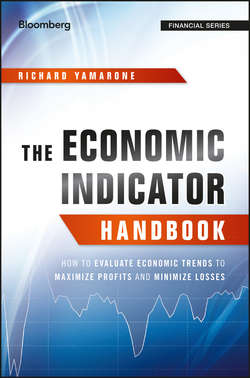Читать книгу The Economic Indicator Handbook - Ричард Ямароне - Страница 7
На сайте Литреса книга снята с продажи.
Chapter 1
The Daily Blotter
ОглавлениеPerhaps the best way to appreciate the most important and meaningful economic indicators used by Wall Street economists is to present them in the manner that they are used by those professionals. Every bank, money manager, hedge fund, or financial institution has an interest in economic indicators, and each of those producing the analysis possesses their own individual routine in which they obtain the data, produce a product, and disseminate their respective analysis. For the most part, Wall Street economists use the Bloomberg Professional service for their data, write a daily newsletter – with oftentimes several updates a day – and send it electronically to their clients, investment professionals, and the media.
This chapter attempts to present the most important information used on Wall Street trading desks, and how the desk economist goes about prepping for the day, understanding and appreciating anything that might move the financial markets or alter the outlook for the economy.
The traditional market reaction to news, events, and economic data – particularly the top tier economic indicators – is usually with respect to what insight the news brings to the entire financial market. While some equity analysts use economic releases to determine the trends in some of their respective industries and stocks, most investment professionals look to see how information will influence the broader markets.
For example, should news break about a refinery fire at an integrated oil company, then there may be an immediate negative reaction to that specific company's stock price. Depending on how severe the damage was to its facilities and how long that refinery would be out of commission would dictate the value of the price adjustment. Similarly, if the refinery was large, producing a tremendous amount of gasoline, then the lost supply could disrupt the commodity market, and send prices higher. This wouldn't upset the entire stock, bond, or currency market, with the damage being concentrated in just the trading of some energy products.
When a major economic release hits the newswires, market participants look at the details with respect to how the information contained in the report will influence the prices of a security.
When economic releases are better than expectations, that is, with a positive or bullish implication, equity prices rise and bond prices fall. Yields on bonds (or fixed-income securities) rise since they are inversely related to prices). The economics behind this is that a stronger economic posting like a large number of jobs added in a month, an increase in the orders for durable goods, or an extremely upbeat reading in consumer confidence, implies companies will be conducting a greater amount of business, which is good for revenues and profits.
The reaction to strong economic data in the fixed income market would be very different. Stronger economic conditions possess potentially inflationary conditions. An increase in demand or production is usually accompanied by greater prices. So exceptionally stronger gains in activity are viewed as inflationary, which erodes the value of a fixed income security. The yields on those bonds would rise since they are inversely related.
The opposite holds true for weak economic reports. In the event that one of the manufacturing condition surveys is less than expectations, industrial production contracts, or housing starts fall, stock prices would sour on that news and bond prices would rise (yields would fall).
While each Wall Street economist has varying responsibilities and individual routines, they do share some common traits. Knowing what releases are scheduled for any given day is atop that list. The economic calendar is so important that vacations and time off is planned around economic releases by order of importance. You never call in sick or walk in late for an Employment Situation release, an FOMC meeting, or a day when three or more top-tier indicators are slated for release.
